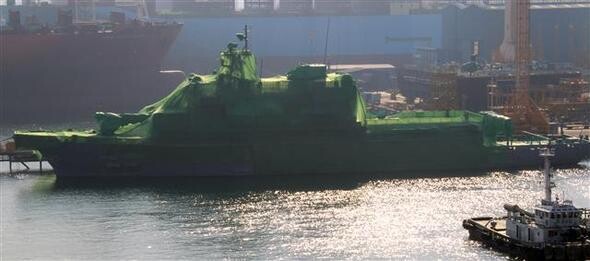hankyoreh
Links to other country sites 다른 나라 사이트 링크
Tongyeong rescue vessel to be deployed, despite faulty equipment

The South Korean military has reportedly decided to push ahead with early deployment of the Tongyeong, a salvage and rescue vessel. The vessel has been flagged as a prime example of corruption in the defense industry. The military’s decision to repair or change several kinds of equipment that do not meet specifications while the ship is under sail is likely to spark further controversy.
“The two rescue vessels that are currently being used by the navy are very old and are close to being retired. In order to fill the gap in our naval rescue capacity that will result, we will have to deploy the Tongyeong soon,” a military officer said on Nov. 24.
The Joint Chiefs of Staff are planning to convene as early as Nov. 28 to make a final decision on the early deployment of the Tongyeong.
The navy currently has two salvage and rescue ships - the Pyeongtaek and the Gwangyang - that are designed to locate, refloat, and haul vessels that have sunk or run aground. The two vessels were built in the UK in the late 1960s and early 1970s and used by the US. After the US navy decommissioned them, they were acquired by the South Korean navy in 1997.
However, the Tongyeong, which has a lightship displacement of 3,500 tons, is still equipped with a hull-mounted sonar and a remotely operated vehicle (ROV) that do not function properly, even though such equipment is required for the ship to fulfill its search and rescue responsibilities.
Lightship displacement refers to how much water the ship displaces when it is not weighed down with cargo.
It is highly unusual for the military to deploy a vessel early when it is unable to serve its purpose due to faulty equipment. There are concerns that putting a ship into service that has a limited ability to carry out its duties could erode the navy’s strategic ability and even lead to an accident.
The Tongyeong has been cited as a typical case of corruption in the defense industry. In July, an audit by the Board of Audit and Inspection (BAI) led to allegations that the Ministry of National Defense had paid 4 billion won (US$3.58 million) for poorly performing sonar that was only worth 200 million won (US$180,000).
When these issues prevented the Tongyeong from being assigned to the rescue work after the sinking of the Sewol ferry in April, there was a public outcry. In response, the navy hastily installed a fish-finding sonar on the ship instead of a military sonar, which raised further questions.
The Tongyeong was launched from the Okpo shipyard of Daewoo Shipbuilding and Marine Engineering in Sep. 2012. However, the navy concluded in an operational evaluation carried out at the end of last year that certain equipment on the ship did not meet the required operational capability (ROC), meaning that the ship was not suited for action.
The decision to deploy the vessel early despite the controversy surrounding it has provoked allegations that the military authorities are trying to release some of the pressure building up from the accusations of graft in the defense industry.
“The early deployment of the Tongyeong and the accusations of corruption during the acquisition process are completely unrelated,” a military official said.
The military is planning to move forward with replacing the problematic sonar and ROV while the ship is in service, a process that is expected to take around two years.
By Park Byong-su, senior staff writer
Please direct questions or comments to [english@hani.co.kr]

Editorial・opinion
![[Guest essay] Preventing Korean Peninsula from becoming front line of new cold war [Guest essay] Preventing Korean Peninsula from becoming front line of new cold war](https://flexible.img.hani.co.kr/flexible/normal/500/300/imgdb/original/2024/0507/7217150679227807.jpg) [Guest essay] Preventing Korean Peninsula from becoming front line of new cold war
[Guest essay] Preventing Korean Peninsula from becoming front line of new cold war![[Column] The state is back — but is it in business? [Column] The state is back — but is it in business?](https://flexible.img.hani.co.kr/flexible/normal/500/300/imgdb/original/2024/0506/8217149564092725.jpg) [Column] The state is back — but is it in business?
[Column] The state is back — but is it in business?- [Column] Life on our Trisolaris
- [Editorial] Penalties for airing allegations against Korea’s first lady endanger free press
- [Editorial] Yoon must halt procurement of SM-3 interceptor missiles
- [Guest essay] Maybe Korea’s rapid population decline is an opportunity, not a crisis
- [Column] Can Yoon steer diplomacy with Russia, China back on track?
- [Column] Season 2 of special prosecutor probe may be coming to Korea soon
- [Column] Park Geun-hye déjà vu in Yoon Suk-yeol
- [Editorial] New weight of N. Korea’s nuclear threats makes dialogue all the more urgent
Most viewed articles
- 1[Column] Why Korea’s hard right is fated to lose
- 2Amid US-China clash, Korea must remember its failures in the 19th century, advises scholar
- 3[Guest essay] Preventing Korean Peninsula from becoming front line of new cold war
- 4Yoon’s broken-compass diplomacy is steering Korea into serving US, Japanese interests
- 5[Column] The state is back — but is it in business?
- 6S. Korean first lady likely to face questioning by prosecutors over Dior handbag scandal
- 7Lee Jung-jae of “Squid Game” named on A100 list of most influential Asian Pacific leaders
- 8After 2 years in office, Yoon’s promises of fairness, common sense ring hollow
- 9[Column] Life on our Trisolaris
- 1060% of young Koreans see no need to have kids after marriage